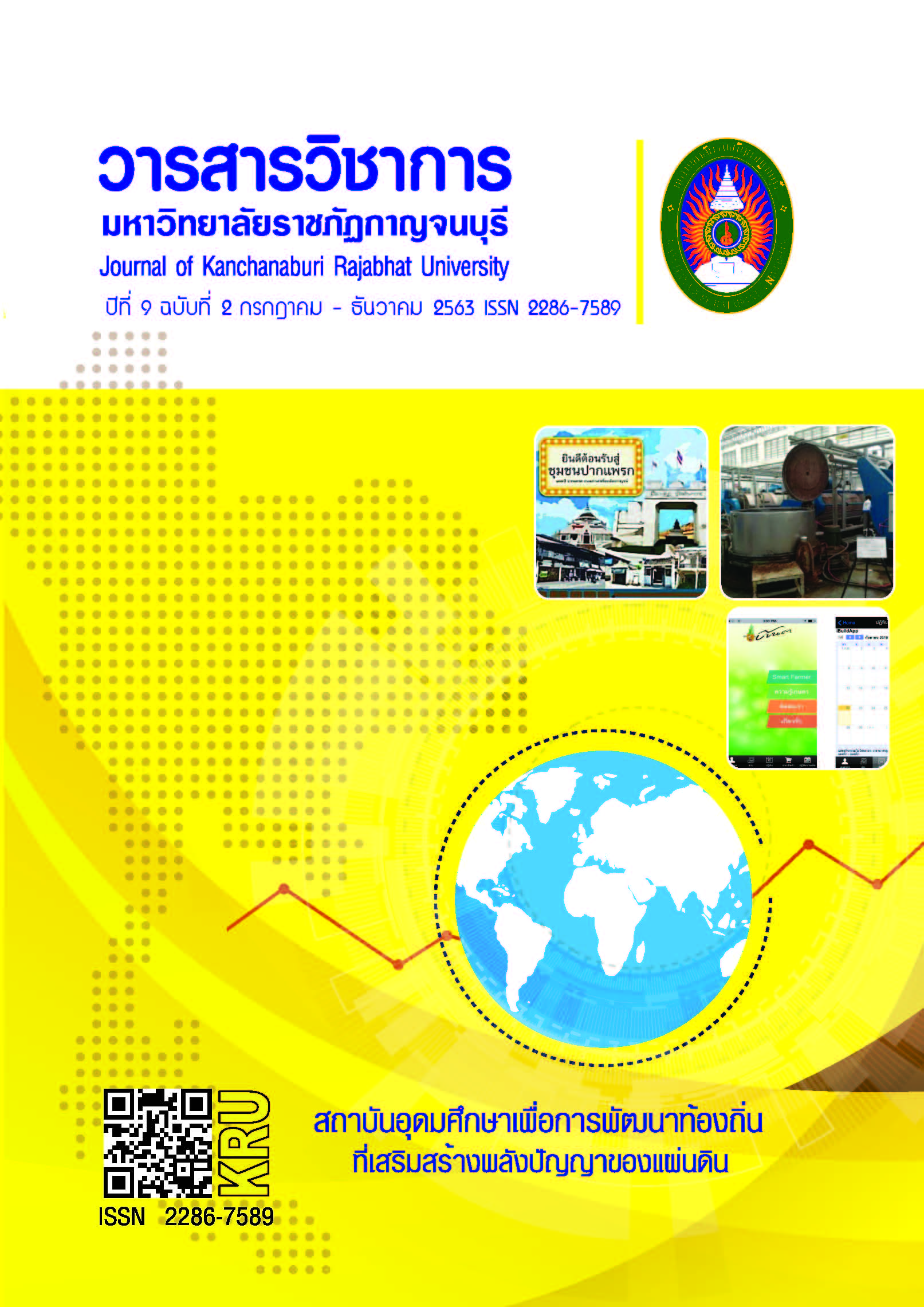INTEGRATED RISK MANAGEMENT AFFECTING THE VALUE ADDED OF THE TOURISM AND SPORTS BUSINESS IN SUPHANBURI PROVINCE
Main Article Content
Abstract
This study aims to 1) investigate the relationship between integrated risk management and an increase in the SMEs value in Suphanburi Province. Integrated risk management consists of operational risk management, regulatory risk management, financial risk management and product market risk management. It is hypothesized as an independent variable in the study. The data were collected from the study’s population comprising 292 SMEs in tourism and hotel business in Suphanburi Province. The statistics used for the data analysis includes multivariate analysis and multiple regression analysis. The results show that integrated risk management, operational risk management and product market risk management have an important positive impact on increasing the SMEs value in Suphanburi Province at the statistically significant level of 0.01. On the other hand, financial risk management and regulatory risk management have no significant positive impact on increasing the SMEs value in Suphanburi Province, with the statistical significance at the 0.10 level.
Article Details
References
กรมพัฒนาธุรกิจการค้า. (2562). คลังข้อมูลธุรกิจ. ค้นเมื่อ มิถุนายน 22, 2562, จาก http://www.dbd.go.th.
นฤนาถ เอี่ยมตระกูล. (2553). การบริหารความเสี่ยงด้านการปฏิบัติงานของฝ่ายก่อสร้าง. วิทยานิพนธ์วิศวกรรม
ศาสตรมหาบัณฑิต สาขาวิศวกรรมโยธา บัณฑิตวิทยาลัย มหาวิทยาลัยรามคำแหง.
นฤมล สะอาดโฉม. (2550). การบริหารความเสี่ยงองค์กร. กรุงเทพฯ: ฐานการพิมพ์.
ปัญจพร ศรีชนาพันธ์. (2547). การบริหารความเสี่ยงของกลุ่มธุรกิจอสังหาริมทรัพย์ในเขตอำเภอเมืองเชียงใหม่.
การค้นคว้าแบบอิสระบัญชีมหาบัณฑิต บัณฑิตวิทยาลัย มหาวิทยาลัยเชียงใหม่.
พรตพร อาฒยะพันธ์. (2550). ผลกระทบของประสิทธิภาพการบริหารความเสี่ยงที่มีต่อผลการดำเนินงาน
ของธุรกิจ SMEs ในเขตกรุงเทพมหานคร. วิทยานิพนธ์การจัดการมหาบัณฑิต สาขาการบัญชี
และการจัดการ บัณฑิตวิทยาลัย มหาวิทยาลัยมหาสารคาม.
วรกานต์ คนอยู่, คำนึง ทองเกตุ และวีรพันธุ์ ศิริฤทธิ์. (2558). การบริหารความเสี่ยงของผู้บริหารสถานศึกษา
ระดับประถมศึกษาที่สอนแบบคละชั้นในเขตภาคเหนือตอนล่าง. Veridian E-Journal, Silpakorn
University, 8(1), 1320-1330.
วาสนา จรูญศรีโชติกำจร.(2550). ผลกระทบของประสิทธิภาพการจัดการโลจิสติกส์ที่มีต่อความได้เปรียบทางการ
แข่งขันของธุรกิจอุตสาหกรรมอาหารในประเทศไทย. วิทยานิพนธ์ปริญญาบริหารธุรกิจมหาบัณฑิต
สาขาวิชาการจัดการเชิงกลยุทธ์ คณะการบัญชีและการจัดการ มหาวิทยาลัยมหาสารคาม.
สุปราณี ทิพยนาสา. (2552). ผลกระทบของประสิทธิภาพการจัดการความเสี่ยงที่มีต่อความสามารถในการ
แข่งขันของธุรกิจ SMEs ในเขตภาคกลาง. วิทยานิพนธ์ หลักสูตรปริญญาบัญชีมหาบัณฑิต
มหาวิทยาลัยมหาสารคาม.
Aaker, David A., Kumar, V. and Day, George S. (2001). Marketing Research. New York:
John Wiley and Sons.
Armstrong, J. S. & Overton Terry S. (1977). Estimating non-response Bias in Mail Surveys.
Journal of Marketing Research, 14, 396-402.
Cronbach, L. (1974). Essentials of Psychological Testing 3rd Ed. New York: Harper and Row.
Gustavo, C & Branddy, R. (2002). The Development of a Measure of Prosocial Behaviors for Late
Adolescents. Journal of Youth and Adolescence, 31(1), 31-44.
Hair, J.F. and others. (2006). Multivariate data analysis. 6th ed. Upper Saddle River, N.J.:
Pearson Education Inc.
Jaccard, J., & Turrisi, R. (2003). Interaction effects in multiple regression. Sage university papers
series. Quantitative applications in the social sciences. Newbury Park: Sage
Publications.
Krejcie, R.V. & Morgan, D.W. (1970). Determining sample size for research activities.
Educational and Psychological Measurement, 30(3), 607-608.
Meulbroek, L.K. (2002). Integrated Risk Management for the Firm: A Senior Manager”s
Guide. Harvard Business School Soldiers Field Road Boston, MA.
Nunnally, J.C., & Bernstein.I, H. (1994). Psychometric theory (3thed.) New York: MC Graw-Hill.

